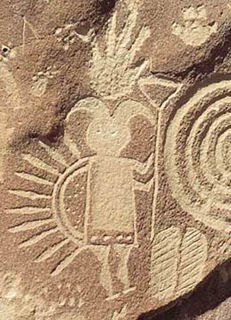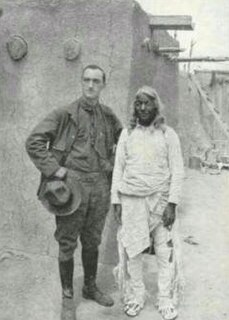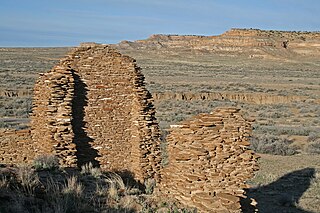
Chaco Culture National Historical Park is a United States National Historical Park hosting the densest and most exceptional concentration of pueblos in the American Southwest. The park is located in northwestern New Mexico, between Albuquerque and Farmington, in a remote canyon cut by the Chaco Wash. Containing the most sweeping collection of ancient ruins north of Mexico, the park preserves one of the most important pre-Columbian cultural and historical areas in the United States.

Pueblo Bonito is the largest and best-known great house in Chaco Culture National Historical Park, northern New Mexico. It was built by the Ancestral Puebloans who occupied the structure between AD 828 and 1126.

Dinétah is the traditional homeland of the Navajo tribe of Native Americans. In the Navajo language, the word "Dinétah" means "among the people" or "among the Navajo". In the geographical sense, Dinétah encompasses a large area of northwestern New Mexico, southwestern Colorado, southeastern Utah, and northeastern Arizona. The boundaries are inexact, and are generally marked by mountain peaks which correspond to the four cardinal directions.

Neil Merton Judd was an American archaeologist who studied under the archaeologist of the American Southwest, Edgar Lee Hewett. He was curator of archaeology at the United States National Museum, part of the Smithsonian Institution. He is noted for his discovery and excavation of ruins left by the Ancestral Pueblo People of the Four Corners area, especially sites located within Chaco Canyon, a region located within the arid San Juan Basin of northwestern New Mexico. He headed the first federally backed archeological mission sent to Chaco Canyon, excavating the key ruins of Pueblo Bonito and Pueblo del Arroyo.

The Chaco Wash is an arroyo cutting through Chaco Canyon, which is located in northwestern New Mexico on the Colorado Plateau. Another arroyo known as Escavada Wash is a tributary that feeds in from the northeast, near the western end of Chaco Canyon. Chaco Wash flows northwest to become the intermittent Chaco River. It is a tributary of the San Juan River.

Wijiji is a Ancestral Puebloan great house and archaeological site located in Chaco Canyon, in New Mexico, United States.

Una Vida is an archaeological site located in Chaco Canyon, San Juan County, New Mexico, United States. According to tree rings surrounding the site, its construction began around 800 AD, at the same time as Pueblo Bonito, and it is one of the three earliest Chacoan Ancestral Puebloan great houses. Comprising at least two stories and 160 rooms, it shares an arc or D-shaped design with its contemporaries, Peñasco Blanco and Pueblo Bonito, but has a unique "dog leg" addition made necessary by topography. It is located in one of the canyon's major side drainages, near Gallo Wash, and was massively expanded after 930 AD.

The Fajada Gap is a geographical feature in the southwestern portion of Chaco Canyon, which is part of the Chaco Culture National Historical Park located in the U.S. state of New Mexico. Surrounding Fajada Butte, it consists of a conspicuous gap penetrating the Chacra Mesa, which comprises much of the southwestern cliff faces hemming Chaco Canyon. Fajada Gap has historically helped funnel summer and winter thunderstorms and accompanying precipitation into the Chaco Canyon area.

Kin Kletso is a Chacoan Ancestral Pueblo great house and notable archaeological site located in Chaco Culture National Historical Park, 25 miles southwest of Nageezi, New Mexico, US. It was a medium-sized great house located 0.5 miles (0.8 m) west of Pueblo Bonito; it shows strong evidence of construction and occupation by Pueblo peoples who migrated to Chaco from the northern San Juan Basin in the time period of 1125 to 1200. From its masonry work, rectangular shape and design Kletso is identified as Pueblo III architecture by prominent Chaco archaeologists Stephen H. Lekson and Tom Windes. They also argue that this great house was only occupied by one or two households. Fagen writes that Kletso contained around 55 rooms, four ground-floor kivas, and a two-story cylindrical tower that may have functioned as a kiva or religious center. Evidence of an obsidian production industry were discovered here. The house was erected between 1125 and 1130.
Nuevo Alto is an Ancestral Puebloan great house and archaeological site located in Chaco Canyon, in the US state of New Mexico.
Casa Chiquita is a Ancestral Puebloan great house and archaeological site located in Chaco Canyon, northwestern New Mexico, United States.

Chetro Ketl is an Ancestral Puebloan great house and archeological site located in Chaco Culture National Historical Park, New Mexico, United States. Construction on Chetro Ketl began c. 990 and was largely complete by 1075, with significant remodeling occurring in the early and mid-1110s. Following the onset of a severe drought, most Chacoans emigrated from the canyon by 1140; by 1250 Chetro Ketl's last inhabitants had vacated the structure.

Pueblo del Arroyo is an Ancestral Puebloan great house and archaeological site located in Chaco Culture National Historical Park, in New Mexico, United States.
The Chaco Slope is a geographical region located in the northwestern portion of the U.S. state of New Mexico. It borders the Chaco Core, which contains both Chacra Mesa and Chaco Canyon. The canyon itself is noted for its Chacoan Anasazi ruins. The Chaco Slope is differentiated from the neighboring Chuska Valley, Chaco Core, and Chaco Plateau by distinct surface water drainage patterns and geological formations. These regions were first labelled by archaeologist Gwinn Vivian.
The Chuska Valley is a geographical region located in the northwestern portion of the U.S. state of New Mexico. Sitting atop the Colorado Plateau in the Four Corners region of the desert Southwest, it is near both Chacra Mesa and Chaco Canyon, which are noted for their Chacoan Anasazi ruins. The Chaco Slope is differentiated from the neighboring Gobernador Slope, Chaco Core, and Chaco Plateau by distinct surface water drainage patterns and geological formations. These regions were first labelled by archaeologist Gwinn Vivian. The valley is associated with the nearby Chuska Mountains.

Hungo Pavi is an Ancestral Puebloan great house and archaeological site located in Chaco Canyon, northwestern New Mexico, United States. A set of ruins located just 1 mile (2 km) from the ruins of Una Vida, Hungo Pavi measured 872 feet (266 m) in circumference. Initial explorations revealed 72 ground-level rooms, with structures reaching four stories in height. One large circular kiva has been identified. Its ruins now lie within Chaco Culture National Historical Park.

Pueblo Alto is an Ancestral Puebloan great house and archaeological site located in Chaco Culture National Historical Park, northwestern New Mexico, United States. The complex, comprising 89 rooms in a single-story layout, is located on a mesa top near the middle of Chaco Canyon; 0.6 miles (1 km) from Pueblo Bonito, it was begun between AD 1020 and 1050. Its location made the community visible to most of the inhabitants of the San Juan Basin; indeed, it was only 2.3 miles (3.7 km) north of Tsin Kletsin, on the opposite side of the canyon. The community was the center of a bead- and turquoise-processing industry that influenced the development of all villages in the canyon; chert tool production was also common. It shares its mesa with another great house, Nuevo Alto, both of which are now protected within the borders of Chaco Culture National Historical Park. Storerooms at Pueblo Alto opened to the outside rather than into the interior rooms and there was a huge midden of pottery. This and chert found in the midden came mostly from the Chuska area 70 km (43 mi) to the west.
Kin Nahasbas is a Chacoan Anasazi great house and archaeological site located in Chaco Canyon, 25 miles southwest of Nageezi, New Mexico, United States. Built in either the 9th or 10th centuries, it was major pueblo located slightly north of the Una Vida complex, which is positioned at the foot of the north mesa. Limited excavation has been conducted in this area. The ruins are now protected within the borders of Chaco Culture National Historical Park.

The Ancestral Puebloans were an ancient Native American culture that spanned the present-day Four Corners region of the United States, comprising southeastern Utah, northeastern Arizona, northwestern New Mexico, and southwestern Colorado. The Ancestral Puebloans are believed to have developed, at least in part, from the Oshara Tradition, who developed from the Picosa culture.

Shabik'eshchee Village is an archeological site located atop Chacra Mesa, New Mexico. Covering 20 acres (8.1 ha), the pit-house settlement was occupied c. 500–700 by Basketmaker III peoples. Discovered by Frank Roberts in 1926, the site is one of the earliest settlements in Chaco Canyon. Shabik'eshchee Village contained one hundred pit houses and a community great kiva. It is located approximately 9 miles (14 km) east of Pueblo Bonito.

















